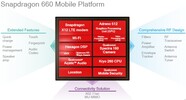Mediatek Helio G85 vs Qualcomm Snapdragon 665 vs Qualcomm Snapdragon 660
Mediatek Helio G85
► remove from comparison
The Mediatek Helio G85 is a mainstream ARM SoC for smartphones (mainly Android based) that was introduced in 2020. It is manufactured in a 12 nm FinFET process and integrates 8 CPU cores. Two fast ARM Cortex-A75 cores with up to 2 GHz for performance tasks and six small ARM Cortex-A55 with up to 1.8 GHz for efficiency. All eight cores can be used together thanks to Heterogeneous Multi-Processing support. The integrated GPU is a ARM Mali-G52 MC2 (MP2) with two clusters at up to 1000 MHz (up from 950 MHz from the otherwise similar Helio G80). The SoC also integrates the HyperEngine that handles a dynamic management of CPU, GPU and memory.
The SoC integrates furthermore a LTE radio with Cat-7 (download) / Cat-13 (upload) support, Wifi 5 (ac), Bluetooth 5.0, LPDDR4x 1800 MHz and eMMC 5.1 storage.
Qualcomm Snapdragon 665
► remove from comparison
The Qualcomm Snapdragon 665 (SM6125) is a fast mid-range ARM-based SoC largely found on Android tablets and smartphones. It features 8 Kryo 260 cores (custom design, 64-Bit capable) that are divided in two clusters. A fast cluster of four cores with up to 2 GHz (Kryo 260 Gold - Cortex-A73 derivate) and a power saving efficiency cluster with up to 1.8 GHz (Kryo 260 Silver - Cortex A53 derivate). Both clusters can also be used together.
In addition to the 8 CPU cores, the SoC integrates a mid range Adreno 610 GPU with a LPDDR4 memory controller (dual-channel) and supports Wi-Fi (802.11ac + MIMO, max. 867 Mbps), Bluetooth 5, and LTE (X12 LTE modem with up to 600 Mbps download and 150 Mbps upload).
Power Consumption
Thanks to the new 11 nm LPP process, the energy efficiency should be quite good.
Qualcomm Snapdragon 660
► remove from comparison
The Qualcomm Snapdragon 660 (SD660) is a fast mid-range ARM-based SoC largely found on Android tablets and smartphones. Announced in mid 2017, the SD660 is the successor to the Snapdragon 625. It features 8 Kryo 260 cores (custom design, 64-Bit capable) that are divided in two clusters. A fast cluster of four cores with up to 2.2 GHz and a power saving efficiency cluster with up to 1.8 GHz. Both clusters can also used together.
In addition to the 8 CPU cores, the SoC integrates a mid range Adreno 512 GPU with a LPDDR4 memory controller (dual-channel 1866 MHz) and supports Wi-Fi (802.11ac + MIMO, max. 867 Mbps), Bluetooth 5, and LTE (X12 LTE modem with up to 600 Mbps download and 150 Mbps upload).
Performance
In Benchmarks of the Oppo R11, the CPU part of the Snapdragon SD660 performs between former high end Socs like the Snapdragon 821 in the Pixel XL and the Snapdragon 835. The graphics performance is however much lower, as the Adreno 512 is only a slight upgrade of the older Adreno 510 (due to the higher clock speed).
CPU
The Snapdragon 660 is based on a similar concept as ARM's big.LITTLE, which combines a low power CPU cluster (2x Kyro clocked at up to 1.8 GHz) and a performance CPU cluster (2x Kyro clocked at up to 2.2 GHz). The clock speed of each cluster can be individually adjusted (but not per core) and the lowest clock speed is 310 MHz (unverified).
Power Consumption
Thanks to the new 14 nm process, the energy efficiency has been improved noticeably compared to its 20 nm predecessors.
| Model | Mediatek Helio G85 | Qualcomm Snapdragon 665 | Qualcomm Snapdragon 660 | ||||||||||||||||||||||||||||||||||||||||||||||||||||||||||||||||
| Codename | Cortex-A75 / A55 | Kryo 260 | Kryo 260 | ||||||||||||||||||||||||||||||||||||||||||||||||||||||||||||||||
| Series | Mediatek Mediatek Helio G | Qualcomm Snapdragon | Qualcomm Snapdragon | ||||||||||||||||||||||||||||||||||||||||||||||||||||||||||||||||
| Series: Snapdragon Kryo 260 |
|
|
| ||||||||||||||||||||||||||||||||||||||||||||||||||||||||||||||||
| Clock | 1800 - 2000 MHz | 2200 MHz | 2200 MHz | ||||||||||||||||||||||||||||||||||||||||||||||||||||||||||||||||
| Cores / Threads | 8 / 8 | 8 / 8 | 8 / 8 | ||||||||||||||||||||||||||||||||||||||||||||||||||||||||||||||||
| Technology | 12 nm | 11 nm | 14 nm | ||||||||||||||||||||||||||||||||||||||||||||||||||||||||||||||||
| Features | 2x Cortex-A75, 6x Cortex-A55 | Adreno 610 GPU, X12 LTE Modem, Hexagon 686 DSP, Specra 165 ISP | Adreno 512 GPU, X12 LTE Modem, Hexagon 680 DSP, Specra ISP | ||||||||||||||||||||||||||||||||||||||||||||||||||||||||||||||||
| iGPU | ARM Mali-G52 MP2 ( - 1000 MHz) | Qualcomm Adreno 610 | Qualcomm Adreno 512 ( - 850 MHz) | ||||||||||||||||||||||||||||||||||||||||||||||||||||||||||||||||
| Architecture | ARM | ARM | ARM | ||||||||||||||||||||||||||||||||||||||||||||||||||||||||||||||||
| Announced | |||||||||||||||||||||||||||||||||||||||||||||||||||||||||||||||||||
| Manufacturer | www.mediatek.com | www.qualcomm.com | www.qualcomm.com |
Benchmarks
Average Benchmarks Mediatek Helio G85 → 100% n=25
Average Benchmarks Qualcomm Snapdragon 665 → 98% n=25
Average Benchmarks Qualcomm Snapdragon 660 → 93% n=25
* Smaller numbers mean a higher performance
1 This benchmark is not used for the average calculation





